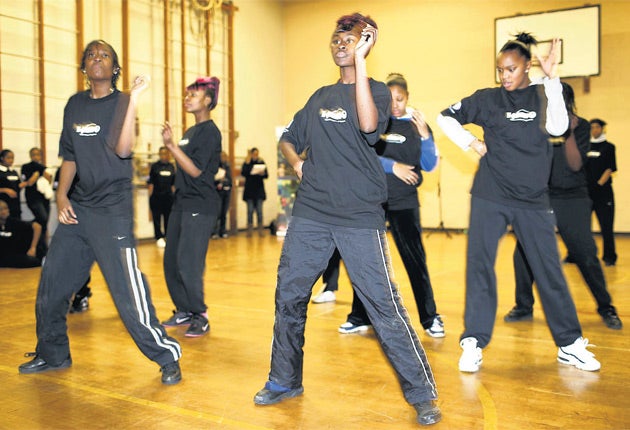Street dance: The beat of the street
Forget ballet, ballroom and tap classes. Street dance has the moves cool kids want to learn. And even Michelle Obama is at it, says Paul McKenzie

The little girl in polka dot leggings is getting her groove on. She smoothes her hand over her head, twists quickly around, feet stepping first to the right, then left. Thirty years ago, eight-year-old girls across the land dreamed of dancing Swan Lake in their ballet classes. Today they are practicing the “Dougie” – the latest street-dance move – and harbouring dreams of starring in a Beyoncé video.
There has been an explosion in the number of seven to 16-year-olds learning moves such as the “running man” and the “cupid shuffle”. Type “UK streetdance classes” into Google and there are more than four million hits, with sessions taking place everywhere from Eastbourne to Edinburgh, Maidstone to Manchester. In schools, it has taken a hold on the curriculum, with 20,000 students a year now taking dance at GCSE level.
Government agencies and health professionals here and in the US have tuned into street dance to capture the imagination of young people. This month, Michelle Obama enlisted the help of Beyoncé Knowles for her “Let’s Move” campaign against childhood obesity. The Move Your Body video sees Beyoncé and a host of children doing the Dougie, the running man and other street-dance moves in a school canteen. Within the first week of its release, it received more than four million hits on YouTube. Not to be outdone, the US First Lady’s very own street-dance moves are making her the latest buzz clip on YouTube. Dancing with students of Alice Deal High School in Washington DC, Mrs Obama’s performance gives the street-dance movement the White House seal of approval.
Alistair Spalding, the artistic director at Sadler’s Wells, believes the dance world is better off now this once-niche form has taken centre stage. He says: “We are getting a younger, more diverse audience coming through our doors.”
He feels street-dance performances, such as the venue’s forthcoming show with Flawless, the dance crew that found fame on ITV’s Britain’s Got Talent, are helping the venue and the world of dance shed its “elite side”. Yet it is not that long ago that established dance venues looked askance at street dance, which traces its roots back to the early hip-hop scene of the late Seventies and early Eighties, and the emergence of breakdancing and bodypopping. It is only in the past decade that this high-energy, often improvisational dance form has moved from clubs to dance classes and gained legitimacy.
Spalding believes there is a valuable trade-off happening between street dance and other forms. “Someone coming to see a street-dance show will pick up a leaflet for a ballet show and think: ‘Why not?’ And vice-versa,” he says. “Street dance has helped dance to go mainstream – and that can only be a good thing.”
Briony Humpris, the artistic director at the Give In To Dance school in Highgate, north London, credits highly-choreographed MTV videos for the growing popularity of street dance at her establishment. “Children will sign up and immediately ask you to teach them the moves they saw in a Chris Brown video on TV or on YouTube,” she explains. Three years ago there would have been three to four children in her street-dance class. Today that number has swelled to as many as 15 to 20 per session.
TV shows such as So You Think You Can Dance, Britain’s Got Talent and Let’s Dance have helped to give the dance form a new audience. But Humpris says the blurring of colour barriers is also making it more universal. “When I started out, I was one of the only white girls i n my c l a s s doing s t re e t dance,” she says. “People presumed you had to be black or have inner-city cool to take part. But now kids see Justin Timberlake or Justin Bieber performing street-dance moves in their videos and it sends out the message that it’s OK for everyone to do it.”
At Chisenhale Dance School in east London, the children are all sunshine smiles as their teacher, Eleanor Thompson, puts them through their paces. I ask them what makes streetdancing so appealing. “It’s a really fun thing to do,” says one little girl, while another says she “loves the songs” they learn to dance to. The school’s head of education, Ava Carlsen, explains: “If we were to advertise two classes, one being street and the other another form of dance, the street dance would be far and away the most popular.”
And it’s not just popular among the girls. The classes have boys flocking through the doors, eager to learn all the latest moves as they imitate their heroes in dance troupes Diversity and Flawless.
Thompson says she sees confidence levels soar among the children she teaches. “The children lose their inhibitions and have tremendous fun while trying to copy the moves to Rihanna’s latest video,” she says, adding quickly: “Of course, we don’t do any of the risqué stuff.” At the studio, children are taught the latest dances, but there’s also a lot of improvising.
“They get to let their imaginations run free and all the while they’re getting a good workout,” says Thompson.
It might seem a world away from the tutus and ballet pumps of more traditional dance classes, but if it’s good enough for America’s First Lady and the reigning queen of R’n’B, there’s room for street-dance at the barre.
Join our commenting forum
Join thought-provoking conversations, follow other Independent readers and see their replies
Comments